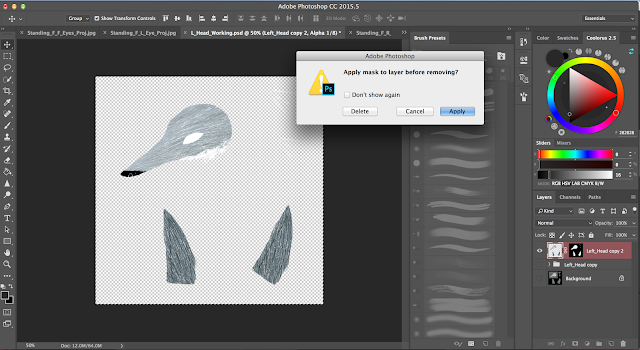 |
| Fig 1. Grizzly Man (2005) |
Grizzly Man is a very unusual film as it is a combination of different types of documentaries. There is no doubt that Grizzly Man has elements of 'shockumentaries' because it exploits Timothy's dangerous life, delusive view of nature and his unhinged, egotistical monologues, "Herzog didn't even have much work to do because Treadwell - gifted, untrained film-maker that he was - had done almost everything himself...they contain sublime, dramatic shots of the bears and footage of his own mad posturing rants to the camera, wearing combats and a bandana - part surfer-dude, part drama-queen," (Bradshaw, 2006). Grizzly Man may also be considered to be a performative documentary. This is because some of the footage used is from Treadwell, who was not only narrating what was going on around him but was also actively participating and engaging with what he was talking about.
 |
| Fig 2. Timothy Treadwell |
Despite Herzog using Treadwell's footage, never once did he belittle the bear enthusiast. While Herzog often discussed his opposing views regarding nature, the fact that he never shamed or mocked the individuals who died is respectable considering they put themselves in the situation. This neutrality indicates that Grizzly Man is also an expository documentary, meaning that the film has a relatively neutral view. Despite the narrator being neutral, many of the individuals being interviewed admitted to thinking that Treadwell was mad, foolish, and ignorant, "Throughout 'Grizzly Man', men and women pay testament to Treadwell's niceness and naïveté. Some are kind; others less so. Each testifier seems to capture some authentic quality of Treadwell, who from evidence of his videos and Mr. Herzog's sympathetic inquiry, seemed equally nice and naive, brave and foolish..." (Dargis, 2005). With 100 hours worth of recordings of Treadwell interfering with nature, spewing narcissistic rants, hinting at conspiracy theories, and consistent proclamations of danger yet complete disregard of said danger makes it very difficult to feel bad for the man's demise. However, remembering that he and his girlfriend were both human beings makes it a sad story despite the foolishness.
Herzog's refusal to pick one side or another and to just present Treadwell's point of view and history while also showing how others think of him paints a more truthful picture for the audience. While he points out that Treadwell's interaction with the bears ultimately did the opposite of his goal to protect the animals, he also praises Treadwell's natural filmmaking ability and his special connection to animals. Herzog continues to show respect for the deceased and their friends and family by being very selective with what was included in the documentary. He decided to not include the actual audio recording of the bear attacking Treadwell and his girlfriend, "Herzog's decision not to play the audio in his film is a wise one, not only out of the respect to the survivors of the victims, but because to watch him listening to it is, oddly, more effective than actually hearing it," (Ebert, 2005). While we never hear the audio, we know it contains Treadwell's his girlfriend attempting to fight the bear off as he screams at her to run away. While there is a dark desire to be able to hear this audio, seeing the disturbed reaction of Herzog is most likely enough.
 |
| Fig 3. Timothy Treadwell with Amie Huguenard |
Overall, Grizzly Man is a very unique documentary as it is a mix of different types of documentary films including exploitation/shockumentary, performative, and expository. The overall composition of the film is why it works as a combination of documentary types. Herzog combined Treadwell's own videos with interviews and his own opinions to give a variety of views for an overall neutral film. This produces mixed feelings from the audience, it is hard to feel bad for Treadwell because even he said it could happen but also declared he had a special bond with the bears. It is clear that he was a very troubled individual who must have just wanted to find a part of the world that he felt like he could fit into. This could have easily been an extremely difficult film to watch, but Herzog tastefully spliced together beautiful, amateur, animal-whisperer shots of nature by Treadwell with harsh, truthful interviews and narration that produced a film that was a disturbing, yet amusing tragedy that wasn't too over the top.
Bibliography:
Bradshaw, P. (2006) Grizzly Man review - Werner Herzog retraces Timothy Treadwell's steps At: https://www.theguardian.com/culture/2006/feb/03/1 Accessed on: 30/11/2016
Dargis, M. (2005) Exploring One Man's Fate in the Alaskan Wilderness At: http://www.nytimes.com/2005/08/12/movies/exploring-one-mans-fate-in-the-alaskan-wilderness.html?_r=0 Accessed on: 30/11/2016
Ebert, R. (2005) Grizzly Man At: http://www.rogerebert.com/reviews/grizzly-man-2005 Accessed on: 30/11/2016
Jolin, D. (2006) Grizzly Man Review At: http://www.empireonline.com/movies/grizzly-man/review/ Accessed on: 30/11/2016
Schager, N. (2005) Grizzly Man At: http://www.slantmagazine.com/film/review/grizzly-man Accessed on: 30/11/2016
Illustration List:
Figure 1. Grizzly Man [Poster] At: http://lionsgatepublicity-archive.com/epk/grizzly/images/ka_lg.jpg Accessed on: 30/11/2016
Figure 2. Timothy Treadwell [Film Still] At: https://s-media-cache-ak0.pinimg.com/originals/da/e9/30/dae930b245499adea29f190e22881275.jpg Accessed on: 30/11/2016
Figure 3. Timothy Treadwell with Amie Huguenard [Film Still] At: https://media.bizarrepedia.com/images/timothy-treadwell-and-amie-huguenard.jpg Accessed on: 30/11/2016















































